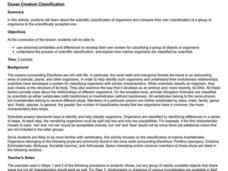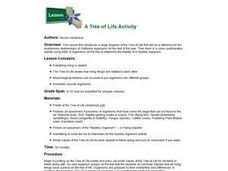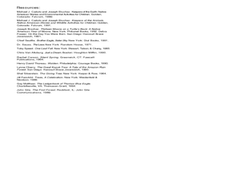Charleston School District
Increasing, Decreasing, Max, and Min
Roller coaster cars traveling along a graph create quite a story! The lesson analyzes both linear and non-linear graphs. Learners determine the intervals that a graph is increasing and/or decreasing and to locate maximum and/or minimum...
CCSS Math Activities
Smarter Balanced Sample Items: 6th Grade Math – Target I
Scholars apply their knowledge of statistical questions to determine which questions meet the criteria. Grade 6 Claim 1 Item Slide Shows offers a couple of practice problems for scholars to discuss.
Curated OER
Ocean Creature Classification
Students develop their own system for classifying a group of objects or organisms using observed similarities and differences. They investigate the process of scientific classification, and explain how marine organisms are classified by...
Curated OER
Classification
In this classification worksheet, learners will look at how biological classification began and how scientific names are used in biology. Students will use a table showing the classification of four organisms to answer 10 short answer...
Curated OER
Seeds and Trees Lesson Plan
Students investigate various tree leaves and use a dichotomous key to classify the leaves. In this leaf classification lesson, students study various types of leaves and their Genus. Students record observations for each Genus.
Curated OER
The Animal Kingdom of Vertebrates
Seventh graders classify fish according to their characteristics. In this classification lesson students learn how to group animals including birds, reptiles and amphibians.
Curated OER
A Tree of Life Activity
High schoolers solve a mystery of the identification of a unknown organism by comparing its morphological characteristics to those in a tree of life classification poster. They compare the observable characteristics of the specimen and...
Curated OER
Food Chains and Food Webs
Young scholars discuss the characteristics of producers, consumers and decomposers. Using a flow chart, they construct a food chain to visually show how organisms with different energy sources depend upon one another. Students explore...
Curated OER
What is a Food Web?
In this food web worksheet, students will brainstorm organisms and classify them as either a consumer, producer, or decomposer. Students will write the organisms under the correct category in this graphic organizer worksheet.
Curated OER
Physical or Chemical Change
In this matter worksheet, students read statements about changes happening to matter and classify the change as either a physical or a chemical change. This worksheet is a graphic organizer.
Curated OER
Which Animals Are Vertebrates?
In this vertebrate animals worksheet, learners will classify 5 animals as belonging to the bird, mammal, reptile, amphibian, or fish group.
Curated OER
Cows, Worms, and Compost
Students study decomposition. In this decomposition lesson, students discuss the background information about decomposition. Students then complete the 'Chew It Twice' worksheet.
Curated OER
Plants
First graders learn the basic needs of plants, label the major parts of a plant and name their uses. They also use a KWL chart.
Curated OER
Origin of Coal
Students explore how coal is formed. They then discuss the information and answer any questions that they may have on the formation of coal. Students then answer questions in reference to the coal discussion and reading.
Curated OER
The Game of Life
Students explore the game of life which refers to what happens to a species when most of the population is gone. In this endangered species activity, students describe what it means for a marine animal to be endangered. Students then...
Curated OER
Plankton
Learners explore how to collect plankton and use microscopes to observe and identify it. They collect the plankton sample and classify the various components of the plankton. Students identify organisms in the plankton and draw...
Curated OER
Sorting and Using Materials
Students explore materials and their properties. In this matter instructional activity, students identify objects and describe their properties. Students test and sort materials using an interactive whiteboard, followed by a group...
Curated OER
Physical and Chemical Changes
In this changes worksheet, students observe and record changes that occur in their every day life and classify these changes as either physical or chemical change. Students record their information in a graphic organizer.
Curated OER
Buzzing is BEE-lieving
Students investigate insects. In this insect lesson, students explore various insect models and identify the characteristics of each. Students observe insects outside and tally how many insects they observe.
Curated OER
Red Tail Ridge Wetland Study Project
Fifth graders use a real life scenario of the wetlands to gather information on creatures of the habitat. In this wetlands activity, 5th graders research the interdependence of organisms in a healthy habitat. Students collected samples...
Curated OER
Sorting Foods
A basic lesson on sorting awaits your charges. They sort a variety of foods while using the food pyramid, and identify the role of the food guide pyramid in helping people eat a healthy diet. Learners use an internet tool to apply their...
Curated OER
Classes of Reactions
Show your chemistry class a graphic organizer classifying the types of chemical reactions. A few additional slides are included on the formation of magnesium chloride, the production of methanol, and a diagram of a mixture of molecules....
Curated OER
Creature Features
Young scholars examine why certain animals live in only specific places throughout the world. Using animals, they classify them based on their characteristics and identify their basic needs. They also observe and compare the life cycles...
Curated OER
Vertebrate Classification Challenge
Students determine which animals belong to the vertebrate phyla. In this classification lesson, students are given large papers with the names of the phyla of vertebrates. They must work together to place organisms into their correct...

























